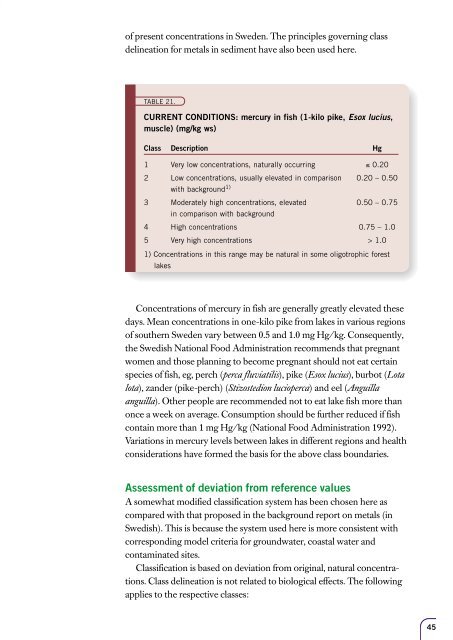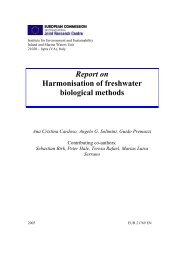Lakes and Watercourses
Lakes and Watercourses
Lakes and Watercourses
Create successful ePaper yourself
Turn your PDF publications into a flip-book with our unique Google optimized e-Paper software.
of present concentrations in Sweden. The principles governing class<br />
delineation for metals in sediment have also been used here.<br />
TABLE 21.<br />
CURRENT CONDITIONS: mercury in fish (1-kilo pike, Esox lucius,<br />
muscle) (mg/kg ws)<br />
Class Description Hg<br />
1 Very low concentrations, naturally occurring ≤ 0.20<br />
2 Low concentrations, usually elevated in comparison 0.20 – 0.50<br />
with background 1)<br />
3 Moderately high concentrations, elevated 0.50 – 0.75<br />
in comparison with background<br />
4 High concentrations 0.75 – 1.0<br />
5 Very high concentrations > 1.0<br />
1) Concentrations in this range may be natural in some oligotrophic forest<br />
lakes<br />
Concentrations of mercury in fish are generally greatly elevated these<br />
days. Mean concentrations in one-kilo pike from lakes in various regions<br />
of southern Sweden vary between 0.5 <strong>and</strong> 1.0 mg Hg/kg. Consequently,<br />
the Swedish National Food Administration recommends that pregnant<br />
women <strong>and</strong> those planning to become pregnant should not eat certain<br />
species of fish, eg, perch (perca fluviatilis), pike (Esox lucius), burbot (Lota<br />
lota), z<strong>and</strong>er (pike-perch) (Stizostedion lucioperca) <strong>and</strong> eel (Anguilla<br />
anguilla). Other people are recommended not to eat lake fish more than<br />
once a week on average. Consumption should be further reduced if fish<br />
contain more than 1 mg Hg/kg (National Food Administration 1992).<br />
Variations in mercury levels between lakes in different regions <strong>and</strong> health<br />
considerations have formed the basis for the above class boundaries.<br />
Assessment of deviation from reference values<br />
A somewhat modified classification system has been chosen here as<br />
compared with that proposed in the background report on metals (in<br />
Swedish). This is because the system used here is more consistent with<br />
corresponding model criteria for groundwater, coastal water <strong>and</strong><br />
contaminated sites.<br />
Classification is based on deviation from original, natural concentrations.<br />
Class delineation is not related to biological effects. The following<br />
applies to the respective classes:<br />
45















![Accommodation booking form [PDF]](https://img.yumpu.com/39471785/1/184x260/accommodation-booking-form-pdf.jpg?quality=85)

